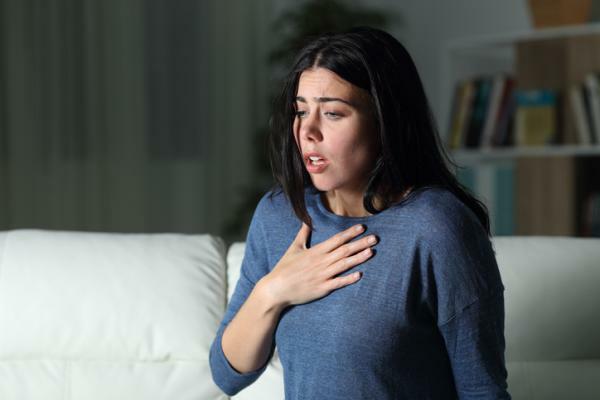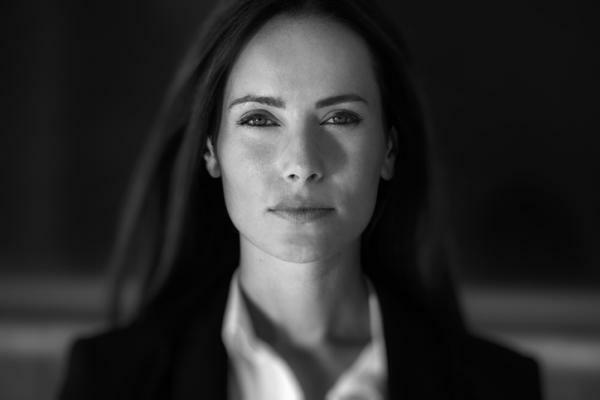
Suffering anxiety in our society is a very frequent natural response of our body, due to the daily speed to which we are subjected. However, this natural and transitory response of our body can be prolonged and become a psychiatric disorder. At present, it is one of the main reasons for medical consultation and against this we must ask ourselves how can I differentiate anxiety as a normal response to pathological anxiety? To answer this question, keep reading this Psychology-Online article, where we will explain the anxiety disorders: what are they, symptoms, types, causes and treatment.
Index
- What is anxiety?
- What are anxiety disorders?
- Anxiety disorders: symptoms
- Classification of anxiety disorders
- Anxiety disorders: types
- Anxiety disorders: causes
- Anxiety disorders: treatment
What is anxiety?
Anxiety is a response from our body, which is activated by the perception of a threat, in certain situations. Faced with the different circumstances that generate anxiety, the emotional response that is awakened will be different in function of the stimulus that causes it and will be linked to feelings of fear, nerves, worry and / or restlessness.
Difference between anxiety and anxiety disorder
Anxiety as an emotion or natural response will be transitory, disappearing when the threatening stimulus is not present, in Against anxiety as a disorder, the emotional response can be maintained, even without the presence of the stimulus, in an anticipatory and the fear that is felt towards this stimulus will be excessive because of the real danger it represents.
What are anxiety disorders?
Anxiety disorders are a group of psychopathological disorders that have in common an excessive manifestation of anxiety.
Anxiety disorder: definition
An anxiety disorder is defined as a response of our body disproportionate to the stimulus to which it responds, that is, it is characterized by excessive fear and in the face of this disabling fear, the person seeks to avoid the situation or object that causes said fear. Anxiety in psychiatric terms can be prolonged over time.
The intense feelings of anxiety that occur, carry interference in everyday life of the person, affecting their daily activities, in such a way that they promote associated behavioral changes. Generally, anxiety tends to be associated with a specific stimulus or situation, giving rise to different anxiety disorders, such as: generalized anxiety disorder, social anxiety disorder, separation anxiety, agoraphobia, panic disorder, selective mutism, and phobias simple.
Anxiety disorders: symptoms.
As there are different presentations of anxiety as a psychiatric disorder, symptoms may vary based on different disorders. However, among them is a shared symptomatology, grouped into physical, psychological, behavioral, intellectual or cognitive and social symptoms.
- Physical: an increased heart rate, hyperventilation, sweating, tremors, a feeling of fatigue, gastrointestinal problems and sleep disturbances may manifest.
- Psychological: the most representative symptom of anxiety disorders is fear of the stimulus presented, in addition to fear of losing control, fear of dying, the need to avoid the feared situation, feelings of danger and threat and uncertainty or unsafety. In the following article you can see specifically what is fear in psychology.
- Behavioral- People suffering from an anxiety disorder are in a constant state of alert and hypervigilance. In addition, impulsivity, motor agitation, or hyperactivity may occur. Changes are also expressed in body expressiveness, as well as in body language, appearing in rigid postures, imprecise movements and changes in the voice.
- Intellectual or cognitive: The high anxiety that occurs causes difficulties in concentrating or paying attention, as well as alterations in memory. On the other hand, thoughts of an irrational and negative nature, as well as catastrophic, tend to appear.
- Social: anxiety tends to affect the social sphere, due to the fear that the person suffers it tends become irritable and becomes blocked when speaking, which is why a tendency to isolation.
Classification of anxiety disorders.
As we have previously mentioned, there are various types of anxiety disorders, which we will briefly present below.
DSM-V anxiety disorders
According to the DSM-V, the types of disorders found within anxiety disorders are the following:
- Generalized anxiety disorder
- Social anxiety disorder (social phobia)
- Separation anxiety disorder
- Agoraphobia
- Panic disorder
- Selective mutism
- Specific phobias
- Substance / Medication-Induced Anxiety Disorder
- Anxiety disorder due to another medical condition
- Other specific and non-specific anxiety disorders
ICD-10 anxiety disorders
On the other hand, in the ICD-10 Anxiety disorders are called neurotic disorders, secondary to stressful and somatoform situations, about which we can find:
- Phobic anxiety disorder, which includes agoraphobia, with or without panic attack, social phobia, and specific phobia.
- Panic disorder
- Generalized anxiety disorder.
- Mixed anxiety-depressive disorder.
- Obsessive-compulsive disorder.
- Reactions to severe stress and adjustment disorders.
- Dissociative (conversion) disorders
- Somatoform disorders
- Other specific and non-specific anxiety disorders
Anxiety disorders: types.
As we have seen, there are various types of anxiety disorders, let's take a closer look at them:
- Generalized anxiety disorder: in the generalized anxiety disorder the persistent fear that the person feels is not focused on a single stimulus, as it may present excessive concern towards various situations and / or objects.
- Social anxiety disorder: in this case, anxiety is concentrated in social situations, where the person feels intense fear about interaction with others and about social situations. As a result, they tend to be shy, anxious, and can lead to isolation. On the other hand, feelings of shame, fear of being judged and / or insecurities may appear.
- Separation anxiety disorder: This disorder tends to appear in childhood and is characterized by a persistent fear of separation from loved ones, usually father figures. The following article specifically explains the separation anxiety disorder in childs.
- Agoraphobia: This type of anxiety refers to the irrational fear of frequenting places or situations in which escaping from them can be difficult or embarrassing. People with this disorder have an intense fear of not being able to have help in the event of a panic attack or high levels of anxiety. Therefore, they tend to isolate themselves at home. If you think you have these symptoms, you can perform the agoraphobia test.
- Panic disorder: many of the anxiety disorders can trigger a panic attack, but this would be associated with the phobic stimulus. However, panic disorder is characterized by the sudden onset of a terror attack, without the appreciation of apparent danger, where the person feels that he is losing control.
- Selective mutism: the selective mutism it is related to the inability to speak in certain circumstances or situations, without being incapacitated at other times. It tends to appear in childhood, causing problems at the school level.
- Simple phobias: this type of anxiety refers to the anxiety caused by a specific stimulus, such as: going by plane, spiders,... anxiety appears when this phobic stimulus occurs, either in reality, in anticipation or imagining it. The following article shows different types of phobias.
- Substance / Medication-Induced Anxiety Disorder: anxiety symptoms appear produced by the consumption of a substance or medicine.
- Anxiety disorder due to another medical condition: anxiety symptoms are underlying a medical condition.
- Mixed anxiety-depressive disorder: This disorder occurs in the presence of depressive and anxious symptoms, in combination, without one prevailing over the other. Comorbidity between both disorders is very common. In the following article you will find more information about the mixed anxiety depressive disorder.
- Obsessive compulsive disorder: the obsessive compulsive disorder (OCD) appears in the face of the recurrence of obsessive thoughts, about which the person has the need to alleviate the anxiety that these cognitions produce with compulsions, such as rituals. For example, a person who has an excessive fear of germs, to combat this anxiety, feels the need to wash and disinfect your hands every time you shake someone's hand or touch an object on the Street.
- Reactions to severe stress and adjustment disorders: This disorder appears in the presence of a stressful life event, a life change or circumstances unpleasant, that in the face of the high levels of stress that these situations derive, a disorder of adaptation to them.
- Dissociative (conversion) disorders: the dissociative disorders appears before high levels of anxiety or a serious psychological conflict, over which the person separates from their own consciousness, memory, environment, actions and identity, is separated from its reality for a short period of time, in a way involuntary.
- Somatoform disorders: It is characterized by excessive concern about the symptoms presented, investing much of their time on these symptoms. This concern persists even though you have been informed of the non-existence of a physical illness. In the following article you will find more information about somatoform disorders.
- Other specific and non-specific anxiety disorders: This term is used against anxieties and phobias that meet criteria to be called an anxiety disorder, but not enough to be able to categorize them in a specific classification.
Anxiety disorders: causes.
Previously, anxiety disorders were causally linked to intrapsychic factors, not However, it is currently known that the factors that cause these disorders. The causes of the most common anxiety disorders are the following:
- Biological factors: a biological vulnerability has been established that is related to a greater probability of suffering an anxiety disorder, being more representative in panic disorder, OCD and phobia Social.
- Psychosocial factors: psychosocial stressors play one of the most important roles in anxiety disorders, as causal factors. The different problems that we face in our day to day, such as problems economic, couple, with friends, duels,... are the main causes of the appearance of such disorders.
- Traumatic factors: traumatic events, such as rapes, serious accidents,... tend to produce high levels of anxiety, usually evoking an anxiety disorder.
- Cognitive and behavioral factors: Anxiety disorders appear before a set of irrational thoughts and against this, a set of behavioral actions are triggered. These negative, distorted, irrational, and excessive cognitions can trigger an anxiety disorder.
- Conditioning: by learning from responses or behaviors of other people, anxiety disorders can also develop.
Anxiety disorders: treatment.
The treatment of anxiety disorders may be different depending on the type of disorder presented anxiety. However, there is a set of common elements that are developed in all his interventions. The therapy that has proven to be the most effective for treating anxiety disorders is cognitive behavioral therapy (CBT).
CBT has the objective of converting irrational thoughts, about the feared stimulus, into healthy thoughts and more limited to reality, with the technique of cognitive restructuring, which has the purpose of replacing these negative automatic thoughts with more positive ones and with it, reducing the levels of anxiety that appear before these thoughts.
On the other hand, it works with relaxation techniques, in order to reduce the levels of stress and anxiety associated with the specific fear.
It should be added that disorders such as simple phobias maintain specific treatments, such as exposure technique gradual, which consists of exposing the person to the feared stimulus progressively and therefore a list of hierarchies that go from the approach to the simplest phobic stimulus, until the person is able to face the fear directly.
A complementary technique to any therapy is mindfulness practice, whose objective is to pay attention to the present. Helps decrease the constant anticipation characteristic of anxiety.
In addition to this, psychopharmacological therapy is often necessary, with drugs such as antidepressants or anxiolytics.
This article is merely informative, in Psychology-Online we do not have the power to make a diagnosis or recommend a treatment. We invite you to go to a psychologist to treat your particular case.
If you want to read more articles similar to Anxiety disorders: what are they, symptoms, types, causes and treatment, we recommend that you enter our category of Clinical psychology.
Bibliography
- Beck, A. T., Emery, G., & Greenberg, R. (2014). Anxiety disorders and phobias. A cognitive perspective.
- Cano-Vincel, A., Dongil-Collado, E., Salguero, J. M., & Wood, C. M. (2013). Cognitive-behavioral intervention in anxiety disorders: an update. Psychological Information, (102), 4-27.
- Feliú, M. T. (2014). Anxiety Disorders in DSM-5. Notebooks of psychosomatic medicine and liaison psychiatry, (110), 62-69.
- Montelongo, R. V., Lara, A., Morales, G., & Villaseñor, S. (2005). Anxiety disorders. University Digital Magazine, 11, 1-11.
- Orozco, W. N., & Baldares, M. J. V. (2012). Anxiety disorders: a review directed for primary care. Medical Journal of Costa Rica and Central America, 69 (604), 497-507.
Anxiety disorders: what are they, symptoms, types, causes and treatment


